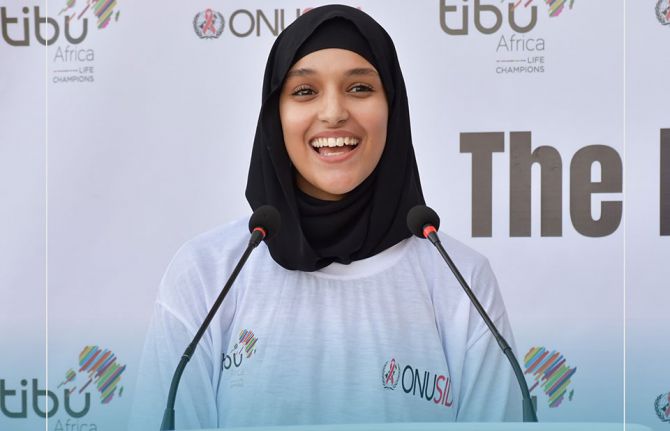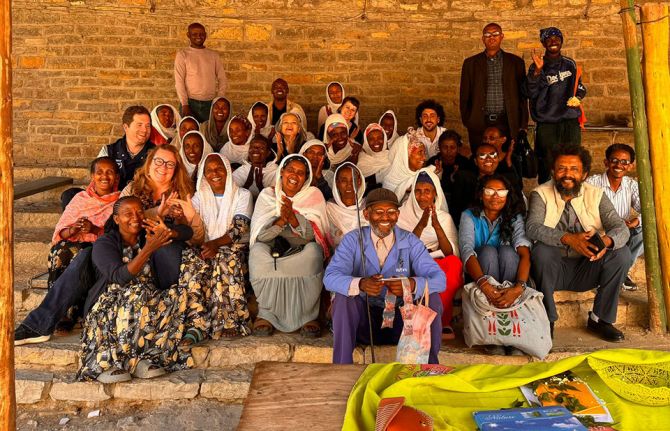
Feature Story
Young people in the AIDS response: Taking the lead
10 June 2011
10 June 2011 10 June 2011
A youth delegate from Liberia hands over 19 775 endorsements for the ‘Mali Call to Action’ to UNAIDS Executive Director Michel Sidibé and UNAIDS Goodwill Ambassador HRH Crown Princess Mette-Marit at the youth-side session during the High Level Meeting on AIDS – pictured here with moderator James Chau (right).
Credit: UNIC
Young people are at the heart of the AIDS epidemic and should be at the heart of the AIDS response. Every day an estimated 2 500 people aged 15-24 are infected with HIV and this accounts for more than 40% of new infections of all people aged 15 and over. The situation is especially stark for girls and young women who make up 60% of the five million young people living with HIV worldwide; this figure reaches more than 70% in sub-Saharan Africa.
A side-event at the High Level Meeting on AIDS in New York explored the need to ensure that the global AIDS response better serves the needs of young people, showing them greater commitment and opportunities for engagement.
The event, which took place on 9 June, was co-organized by UNAIDS, UNICEF, UNFPA, UNESCO, ILO and WHO on behalf of the UNAIDS Interagency Task Team on HIV and Young People. It was moderated by James Chau, National UNAIDS Goodwill Ambassador for China, and attracted top level participation. Those attending included HRH Crown Princess of Norway, Mette-Marit, UNAIDS International Goodwill Ambassador; Michel Sidibé, UNAIDS Executive Director; UNFPA Executive Director Babatunde Osotimehin; Martin Mogwanja, Deputy Executive Director of UNICEF and Remmy Shawa, Global Youth Campaigns Coordinator for the World AIDS Campaign.
For a young person, it is really important to have health care services, especially if you want to talk to your doctor about something that affects you
Pablo Torres Aguilera, a youth delegate from Mexico attending the High Level Meeting on AIDS
In his opening remarks UNFPA Executive Director Babatunde Osotimehin noted, “UNFPA has experienced first-hand the leadership of young people in HIV prevention programmes around the world. We have learnt that we can reverse the AIDS epidemic if we work in partnership with young people”.
Also calling for the need for AIDS responses that meet the needs of young people, was HRH Crown Princess of Norway, Mette-Marit. She said: “Despite the immense progress on scaling up the global AIDS response, great challenges remain. Young people are particularly vulnerable to HIV infection and they must have access to information and services to help them protect themselves against HIV.”
The event was intended to examine transformative and practical ways of mobilizing young people to take the lead in the AIDS response. It also built on the Call to Action from April’s Global Youth Summit in Mali in which some 150 young HIV activists came together to spearhead a youth-led response to the epidemic.
Young people were out in force at Thursday’s event and said they were ready to take the lead and become fully involved in the challenge to HIV as agents of change with their own ideas, voices and demands.
Pablo Torres Aguilera, a young man living with HIV from Mexico, attended the High Level Meeting as a youth delegate. He explained his hopes for the meeting. “I would really like to see a change in how governments make new policies and laws. The High Level Meeting is really important because it affects everyone in the world, especially youth. The [meeting] is going to affect us because we are talking about sexuality education in schools; we are talking about youth friendly services in hospitals; and for a young person, it is really important to have health care services, especially if you want to talk to your doctor about something that affects you.”
The gathering also presented an opportunity to show the most recent evidence on the HIV prevention response for young people as contained in the new Opportunity in Crisis, 2011 report.
UNICEF Deputy Executive Director Martin Mogwanja presented some of the findings of the publication which highlights the need for family members, teachers, communities, leaders and young people themselves to play a role in changing behaviours which place young people at risk of HIV and establish set norms leading to a safer environment. This should take place in a multi-faceted continuum of HIV prevention which provides information, support and services.
Recognizing the need to maintain momentum participants committed to key actions to help prevent HIV among young people and involve them in the response: A clear consensus emerged from the event: the global AIDS response cannot succeed without the greater centrality of young people.
UN General Assembly High Level Meeting on AIDS
Thirty years into the AIDS epidemic, and 10 years since the landmark UN General Assembly Special Session on HIV/AIDS, the world has come together to review progress and chart the future course of the global AIDS response at the 2011 UN General Assembly High Level Meeting on AIDS from 8–10 June 2011 in New York. Member States are expected to adopt a new Declaration that will reaffirm current commitments and commit to actions to guide and sustain the global AIDS response.


